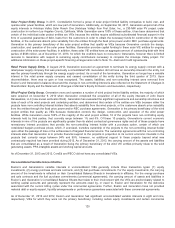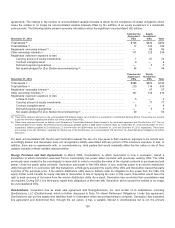ComEd 2013 Annual Report Download - page 141
Download and view the complete annual report
Please find page 141 of the 2013 ComEd annual report below. You can navigate through the pages in the report by either clicking on the pages listed below, or by using the keyword search tool below to find specific information within the annual report.Pennsylvania retail electric customersshall begeneratedfromcertain alternative energy resourcesasmeasuredinAECs. The
requirement for electric energy that mustcomefromTier Ialternative energy resourcesrangesfromapproximately3.5% to 8% and
therequirement for Tier II alternative energy resourcesrangesfrom6.2%to 10%. Therequiredcompliance percentages
incrementallyincreaseeach annual compliance period, which is fromJune 1 through May31,untilMay31,2021.TheseTier Iand
Tier II alternative energy resourcesincludeacceptable energy sourcesasset forthinAct129andtheAEPS Act.
PECO hasenteredinto five-year andten-year agreementswithaccepted bidders, includingGeneration,totaling452,000 non-solar
and8,000 solar Tier IAECs annuallyinaccordancewithaPAPUC approvedplan.The plan allowed PECO to bankAECs procured
prior to 2011 andusethebankedAECs to meet itsAEPS Actobligationsover twocomplianceyearsendingMay2013.ThePAPUC
also approvedthe procurement ofTier II AECs andsupplemental AECs aswell asthesale ofexcess AECs through independent
third-partyauctionsor brokers.
All AEPS administrativecostsandcostsofAECs incurredafter December 31,2010 are beingrecoveredon a full andcurrent basis
fromdefault servicecustomersthrough asurcharge.
PECO’s second DSP ProgrameliminatedtheAEPS surcharge.BeginninginJune 2013,AEPS compliancecostsare being
recoveredthrough theGSA.
Investigation of Pennsylvania Retail Electricity Market OnJuly28, 2011,thePAPUC issuedan order outliningthenextstepsin
itsinvestigation into thestatusofcompetition inPennsylvania’s retail electric market.ThePAPUC foundthat theexistingdefault
servicemodel presentssubstantial impedimentsto thedevelopment ofavibrant retailmarket inPennsylvaniaanddirectedits Office
ofCompetitiveMarketsOversighttoevaluate potential intermediate andlong-termstructural changesto thedefault servicemodel.
OnMarch 1,2012,thePAPUC issuedthefinal order describingmore detailedrecommendationsto beimplementedprior to the
expiration ofthe electric distribution company’s current default service plan andprovidingguidelinesfor electric distribution
companiesfor development oftheirnextdefault service plan.OnOctober 12,2012,thePAPUC approved PECO’s second DSP
Program, which includesseveral newprograms to continue PECO’s support ofretailmarket competition inPennsylvaniain
accordancewiththeorder issuedbythePAPUC on December 15, 2011.Further,thePAPUC issuedafinal order on February14,
2013,outliningitsproposedend-state for default service, which includeddefault servicepricingfor residential andsmall commercial
customersbasedon three monthfull requirementscontracts, full requirement contractsusinghourlyspot market pricingfor large
commercial andindustrial default servicecustomers, andtheinclusion ofCAPcustomersinthecustomer choice programs.
Pennsylvania Act 11 of 2012 OnFebruary13,2012,Act11was signedinto lawbytheGovernor.Act11seeks to clarify the
PAPUC’s authorityto approve alternative ratemakingmechanisms, which wouldallowfor theimplementation ofadistribution system
improvement charge(DSIC) in ratesdesignedto recover capital projectcostsincurredto repair,improve or replaceutilities’ aging
electric andnatural gas distribution systems inPennsylvania.Act11alsoincludesa provision that allows utilitiesto useafully
projectedfuture testyear under which thePAPUC maypermittheinclusion ofprojectedcapital costsin rate basefor assetsthat will
be placedinserviceduringthefirstyear ratesare ineffect.OnAugust2,2012,thePAPUC issuedafinal order establishingrules
andproceduresto implement the ratemakingprovisionsofAct11.Theimplementation order requiresautilityto haveaLongTerm
Infrastructure Improvement Plan (LTIIP) which outlineshowtheutilityisplanningto increaseitsinvestment for repairing, improving,
or replacingaginginfrastructure,approvedbytheCommission prior to implementingaDSIC. OnMay9,2013,thePAPUC approved
PECO’s LTIIP for itsGasOperations, which wasfiledon February8,2013.
Maryland Regulatory Matters
2011 Maryland Electric and Gas Distribution Rate Case InMarch 2011,theMDPSC issuedacomprehensive rate order setting
forththedetailsofthedecision containedinitsabbreviatedelectric andgas distribution rate order issuedinDecember 2010.Aspart
oftheMarch 2011 comprehensive rate order, BGE wasauthorizedto defer $19million ofcostsasregulatoryassets. Thesecosts
are beingrecoveredover a 5-year periodthat began inDecember 2010 andincludethedeferral of$16million ofstormcosts
incurredinFebruary2010.Theregulatoryasset for thestormcostsearnsaregulatedrate ofreturn.
2012 Maryland Electric and Gas Distribution Rate Case OnJuly27, 2012, BGE filedan application for increasesto itselectric
andgasbase rateswiththeMDPSC. OnFebruary22,2013,theMDPSC issuedan order inBGE’s 2012 electric andnatural gas
distribution rate casefor increasesin annual distribution servicerevenue of$81million and$32 million,respectively. The electric
distribution rate increasewasset usingan allowedreturn on equityof 9.75% andthegas distribution rate increasewasset usingan
allowedreturn on equityof 9.60%. The approvedelectric andnatural gas distribution ratesbecameeffectivefor servicesrenderedon
or after February23,2013.Aspart ofthe rate order,theMDPSC approvedbothrecoveryofandreturn on merger integration costs
135
























